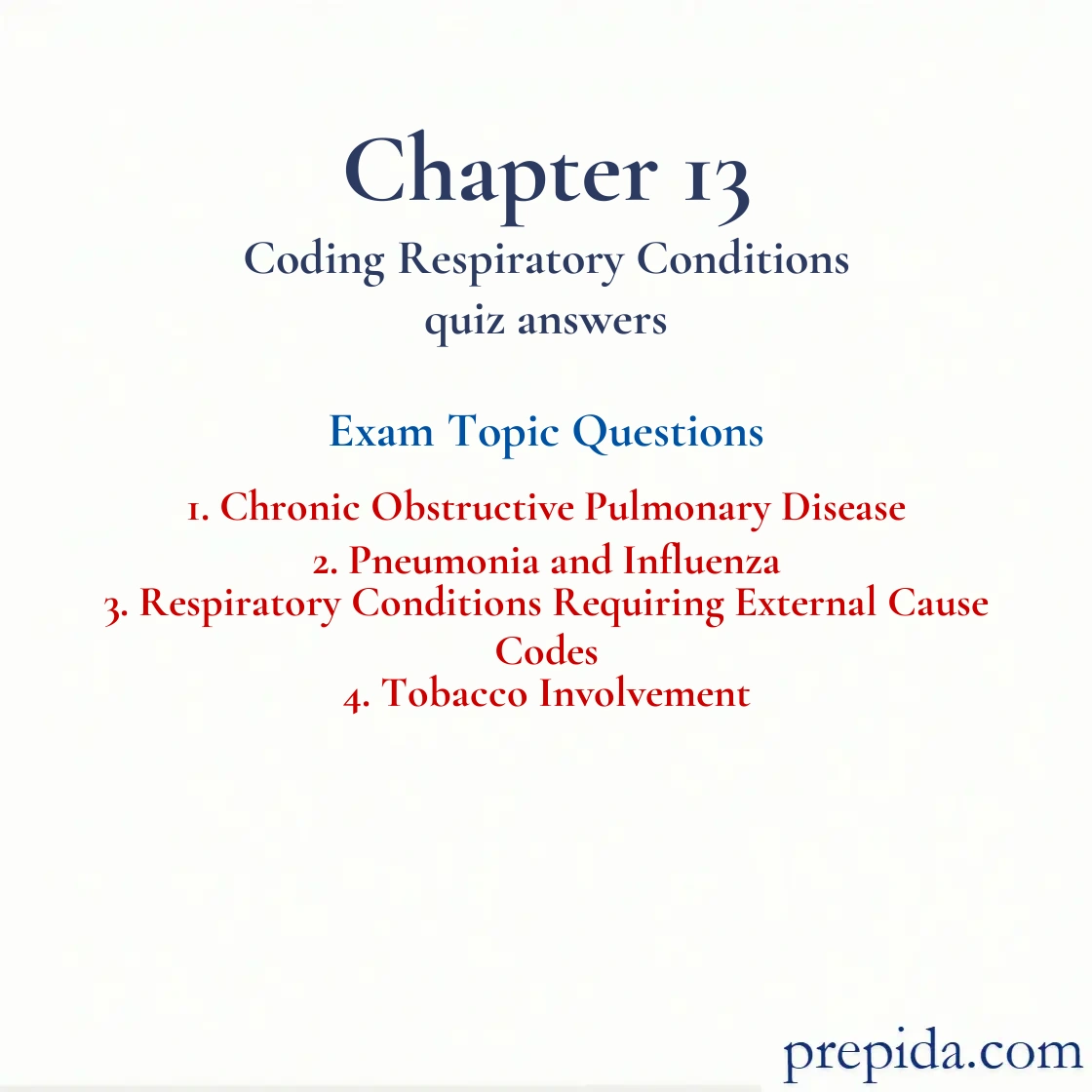
What is/are the correct code(s) for a patient with mucopurulent chronic bronchitis who is a tobacco user?
- J40
- J41.1, Z72.0
- J40, F17.210
- J41.1, Z87.891
The correct codes for a patient with mucopurulent chronic bronchitis who is a tobacco user are J41.1 and Z72.0. J41.1: Index>bronchitis>mucopurulent. Z72.0: Index>use>tobacco.
Chronic: Long duration; continuing over a long period of time.
What is the correct code for a patient with unilateral emphysema?
- J43.0
- J43.1
- J43.2
- J43.9
The correct code for a patient with unilateral emphysema is J43.0. J43.0: Index>emphysema>unilateral.
Diagnosis: A physician’s determination of a patient’s condition, illness, or injury.
What is/are the correct code(s) for a patient with COPD and an acute lower respiratory infection?
- J44.0
- J44.0, J22
- J44.1
- J44.1, J22
The correct codes for a patient with COPD and an acute lower respiratory infection are J44.0 and J22. J44.0: Index>disease>pulmonary>chronic obstructive>with>lower respiratory infection. J22: Index>infection>respiratory>lower.
Acute: Severe; serious.
What is the correct code assigned for a patient with pneumonia due to Klebsiella pneumoniae?
- J15.0
- J15.1
- J15.2
- J15.20
The correct code for a patient with pneumonia due to Klebsiella pneumoniae is J15.0. J15.0: Index>pneumonia>in>Klebsiella.
Pneumonia: An inflammation of the lungs.
What is/are the correct code(s) for a patient with bronchiolectasis with exacerbation from prolonged exposure to environmental tobacco smoke?
- J47.0
- J47.1, Z77.22
- J47.1
- J47.0, Z77.22
The correct codes for a patient with bronchiolectasis with exacerbation from prolonged exposure to environmental tobacco smoke are J47.1 and Z77.22. J47.1: Index>bronchiolectasis>with>exacerbation. Z77.22: Index>exposure>environmental tobacco smoke.
Exacerbation: An increase in the severity of a disease or its symptoms.
What is/are the correct code(s) for a patient with black lung disease from working in a coal mine?
- J60
- J60, T58.2X1A, Y92.64
- J61
- J60, T58.2X2A, Y92.65
The correct codes for a patient with black lung disease from working in a coal mine are J60, T58.2X1A, and Y92.64. J60: Index>disease>lung>black. T58.2X1A: Drug table>coal ~ redirects you to carbon>monoxide>coal>poisoning, accidental. Y92.64: External cause index>place of occurrence>mine.
External Cause: An event, outside the body, that causes injury, poisoning, or an adverse reaction.
What is/are the correct code(s) for a patient transferred to ICU with acute and chronic respiratory failure with hypoxia?
- J96.01
- J96.20
- J96.0, J96.2
- J96.21
The correct code for a patient with acute and chronic respiratory failure with hypoxia is J96.21. J96.21: Index>failure>respiratory>acute and/or chronic>with>hypoxia.
Acute: Severe; serious.
What is the correct term for smoking tobacco on a regular basis?
- Abuse
- Dependence
- Exposure
- Use
Use is the term for smoking tobacco on a regular basis.
What is the correct term for a patient who has a habit of using tobacco and has a daily fixation on smoking tobacco?
- Abuse
- Dependence
- Exposure
- Use
Abuse is when a patient has a habit of using tobacco and has a daily fixation on smoking tobacco.
What is the correct term for a patient who has a compulsive, continuous use of tobacco that has resulted in significant clinical manifestations?
- Abuse
- Dependence
- Exposure
- Use
Dependence is when a patient has a compulsive, continuous use of tobacco that has resulted in significant clinical manifestations.
Manifestation: A condition caused or developed from the existence of another condition.
Which of the following tests is used to check ventilation and perfusion in order to assess the presence of a pulmonary embolus?
- CT
- MRA
- PET
- Scintiphotography
Scintiphotography is used to check ventilation and perfusion in order to assess the presence of a pulmonary embolus.
Which of the following is used to remove fluid from the pleura?
- CT
- Thoracentesis
- Spirometer
- Scintiphotography
A thoracentesis is used to remove fluid from the pleura for pathologic assessment.
Pneumothorax: A condition by which air or gas is present within the chest cavity but outside the lungs.
Which of the following is used to evaluate the patient's ability to exchange gases within the lungs?
- Arterial blood gas
- Thoracentesis
- Spirometer
- Capnography
Arterial blood gas is used to evaluate the patient's ability to exchange gases within the lungs.
Respiration: The physical process of acquiring oxygen and releasing carbon dioxide.
What often causes pleuritis?
- Bacteria
- Fungi
- Gases
- Virus
Pleuritis is often caused by a virus.
Infectious: A condition that can be transmitted from one person to another.
What is the correct code for a persistent air leak?
- J93.81
- J93.82
- J93.83
- J93.9
J93.82 is the correct code for a persistent air leak. J93.82: Index>leak>persistent air.
ICD-9-CM: The acronym for International Classification of Diseases, Ninth Revision, Clinical Modification.
What is the correct term for coming into contact with tobacco smoke?
- Abuse
- Dependence
- Exposure
- Use
Exposure is the term used when a patient has been in contact with tobacco smoke.
Toxic Effect: Poisonous substance causing a health-related reaction.